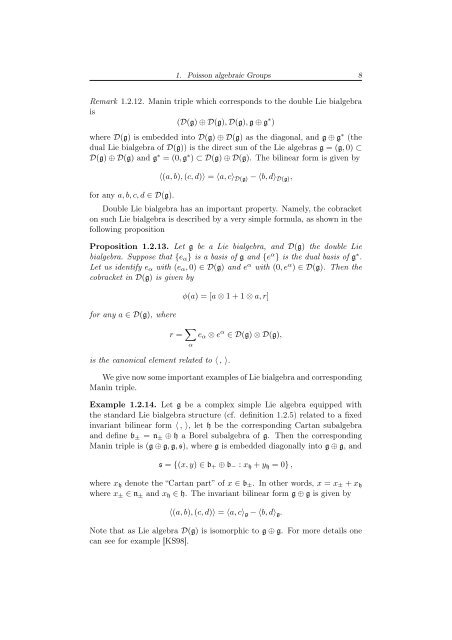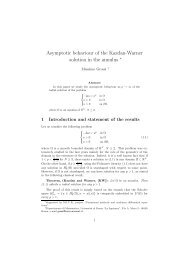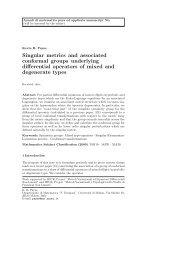Degree of Parabolic Quantum Groups - Dipartimento di Matematica ...
Degree of Parabolic Quantum Groups - Dipartimento di Matematica ...
Degree of Parabolic Quantum Groups - Dipartimento di Matematica ...
You also want an ePaper? Increase the reach of your titles
YUMPU automatically turns print PDFs into web optimized ePapers that Google loves.
1. Poisson algebraic <strong>Groups</strong> 8<br />
Remark 1.2.12. Manin triple which corresponds to the double Lie bialgebra<br />
is<br />
(D(g) ⊕ D(g), D(g), g ⊕ g ∗ )<br />
where D(g) is embedded into D(g) ⊕ D(g) as the <strong>di</strong>agonal, and g ⊕ g ∗ (the<br />
dual Lie bialgebra <strong>of</strong> D(g)) is the <strong>di</strong>rect sun <strong>of</strong> the Lie algebras g = (g, 0) ⊂<br />
D(g) ⊕ D(g) and g ∗ = (0, g ∗ ) ⊂ D(g) ⊕ D(g). The bilinear form is given by<br />
for any a, b, c, d ∈ D(g).<br />
〈(a, b), (c, d)〉 = 〈a, c〉 D(g) − 〈b, d〉 D(g),<br />
Double Lie bialgebra has an important property. Namely, the cobracket<br />
on such Lie bialgebra is described by a very simple formula, as shown in the<br />
following proposition<br />
Proposition 1.2.13. Let g be a Lie bialgebra, and D(g) the double Lie<br />
bialgebra. Suppose that {eα} is a basis <strong>of</strong> g and {e α } is the dual basis <strong>of</strong> g ∗ .<br />
Let us identify eα with (eα, 0) ∈ D(g) and e α with (0, e α ) ∈ D(g). Then the<br />
cobracket in D(g) is given by<br />
for any a ∈ D(g), where<br />
φ(a) = [a ⊗ 1 + 1 ⊗ a, r]<br />
r = <br />
is the canonical element related to 〈, 〉.<br />
α<br />
eα ⊗ e α ∈ D(g) ⊗ D(g),<br />
We give now some important examples <strong>of</strong> Lie bialgebra and correspon<strong>di</strong>ng<br />
Manin triple.<br />
Example 1.2.14. Let g be a complex simple Lie algebra equipped with<br />
the standard Lie bialgebra structure (cf. definition 1.2.5) related to a fixed<br />
invariant bilinear form 〈, 〉, let h be the correspon<strong>di</strong>ng Cartan subalgebra<br />
and define b± = n± ⊕ h a Borel subalgebra <strong>of</strong> g. Then the correspon<strong>di</strong>ng<br />
Manin triple is (g ⊕ g, g, s), where g is embedded <strong>di</strong>agonally into g ⊕ g, and<br />
s = {(x, y) ∈ b+ ⊕ b− : xh + yh = 0} ,<br />
where xh denote the “Cartan part” <strong>of</strong> x ∈ b±. In other words, x = x± + xh<br />
where x± ∈ n± and xh ∈ h. The invariant bilinear form g ⊕ g is given by<br />
〈(a, b), (c, d)〉 = 〈a, c〉g − 〈b, d〉g.<br />
Note that as Lie algebra D(g) is isomorphic to g ⊕ g. For more details one<br />
can see for example [KS98].








